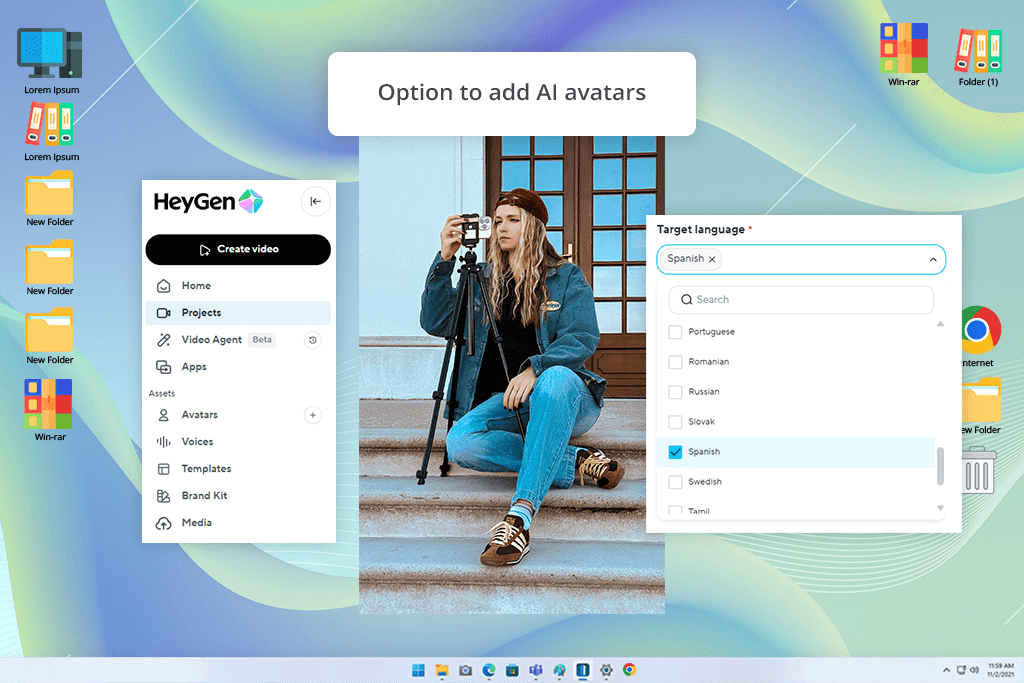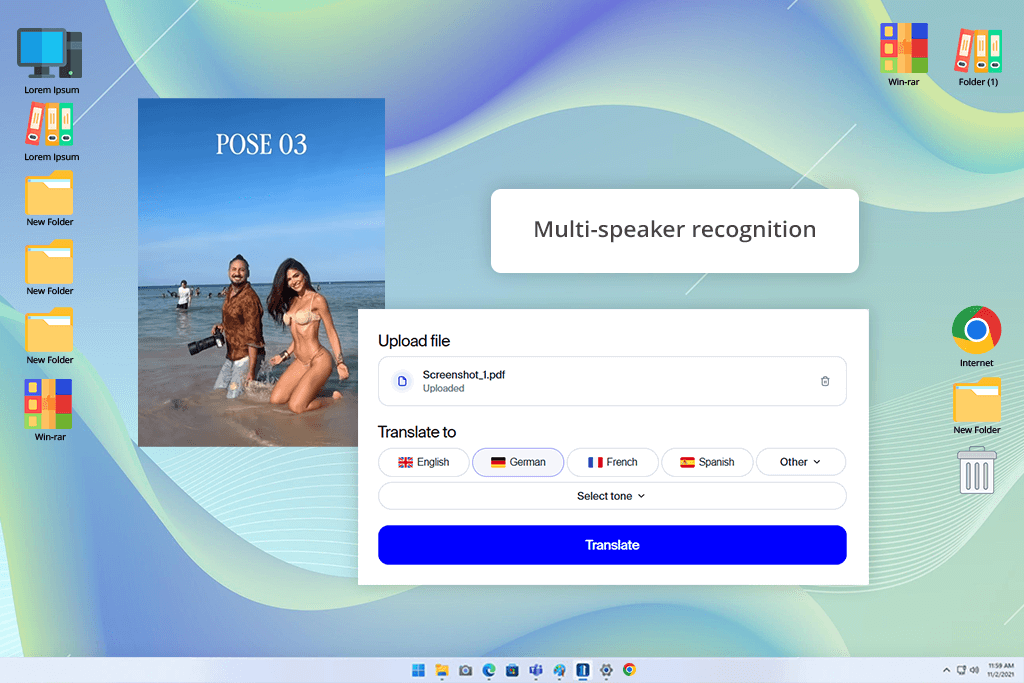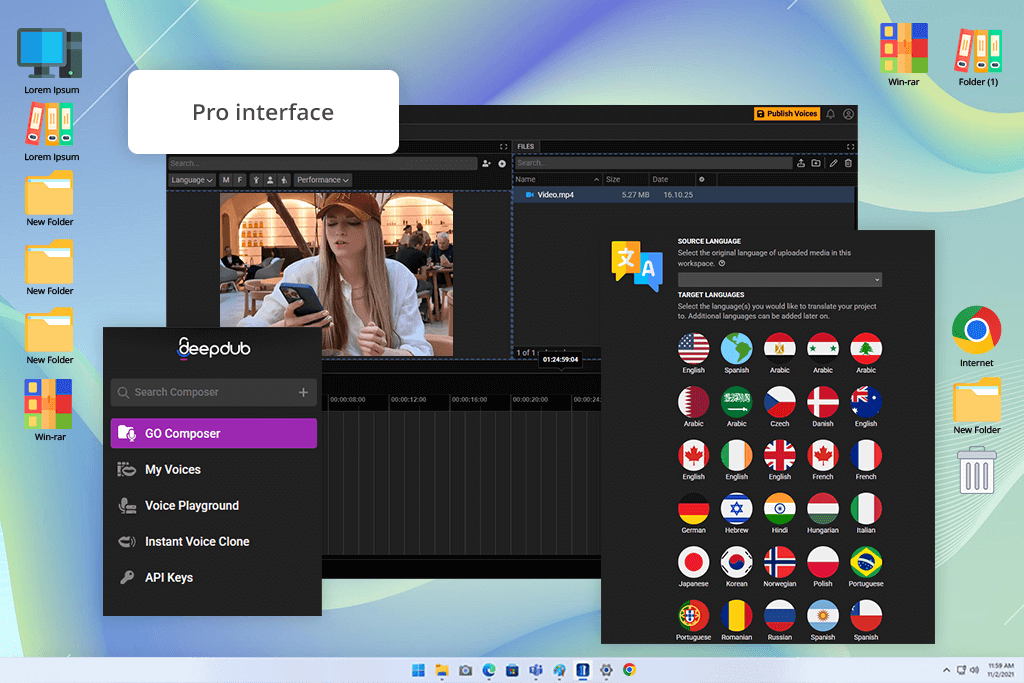As a content creator at FixThePhoto, I chose to write about the best AI dubbing software because I often struggle to make my videos easy to understand for people around the world. Many of our followers also work with international clients, so I wanted to find tools that could help them save time and reach more viewers without losing quality.
To create a genuinely helpful guide, I personally tried over 15 AI dubbing software across various kinds of videos. I did thorough online research, checked user feedback on Quora, Reddit, and YouTube, and talked with my teammates to gather a range of opinions.
These tools helped me work faster and do more. With just a few clicks, I could add voiceovers in different languages to my videos. This let me reach people who like to watch in their own language. However, I found some problems, like voices that sound robotic, words not matching the lip movements, and some technical terms being translated wrong. Even so, a few programs were really good, and I wanted to tell you about them.
| Tool | Dub Quality | Languages | Core Strength | Free Plan |
|---|---|---|---|---|

|
High-quality
|
15+
|
Voice matching, tone, lip-sync support, fast short-video dubbing
|
✔️
|

|
High-quality
|
175+
|
Avatars + dubbing, great for marketing & explainer videos
|
✔️
|

|
Good
|
29
|
Voice cloning, emotional range, narration & dubbing flexibility
|
✔️
|

|
Good
|
60+
|
Easy-to-use interface, quick translations, voice library
|
✔️
|

|
High-quality
|
33+
|
Team collaboration, subtitles + dubbing, localization focus
|
❌
|

|
Good
|
70+
|
Enterprise-level dubbing, cultural adaptation, broadcast quality
|
❌
|

|
Good
|
30
|
Fast turnaround, business/educational dubbing, editing options
|
✔️
|
Here's what I look for in a dubbing app. First, it must translate accurately and have realistic-sounding voices that sync well with the video. I also check if it supports many languages, is easy to edit, and gives me a finished product quickly, without needing a lot of extra work.
When I began testing AI dubbing for my tutorials, I found the main problem wasn't wrong translations - it was losing the feeling in my voice. A flat, robotic voice can make the most exciting tip seem boring. That's why I take extra time to adjust the AI voices to sound natural and lively, more like how I really talk.
Here’s how I make sure the original mood stays the same:
In my experience, you don't get emotion from AI dubbing automatically. It takes testing, making changes, and sometimes creating the audio several times. But when you get it right, it sounds much more like a real person and keeps your audience interested.

Price: Free or from $9.99/mo.
Compatibility: Web, iOS and Android
I often use Adobe Firefly, so I tested its video dubbing feature to see how well it works. For my test, I uploaded a short, three-minute photography tutorial. I selected Spanish and Hindi as the languages I wanted, and let Firefly work on the file. The setup was quick, and in just a few minutes, I had new dubbed versions to watch.
I was very impressed. The tool was easy to use, so I could start right away. It was also accurate - it understood my speech well and even got the special photography terms right. Best of all, the voice quality was great. It sounded natural and human, not like a robot, which is the main thing I look for in a dubbing tool.
Firefly supports over 15 languages, which helped me share my content with many more people. The business plan also includes a lip-sync feature to make videos look more natural. However, there are some limits. The five-minute upload limit is inconvenient for longer tutorials. Also, while 15 languages are a good start, some other dubbing tools offer a much wider selection of languages.
The newest update to this free Adobe software made a real improvement. It now works faster, and the lip-sync is much better. I really liked this upgrade. It shows Adobe is working hard to improve the tool, and for short projects, Firefly has become one of my favorite dubbing apps.

Price: Free (up to 3-mins, 3 videos per month) or from $29/mo.
Compatibility: Web
I tested HeyGen's automatic AI dubbing tool with a short, four-minute tutorial of mine on newborn lighting. The video used technical words like "softbox," "aperture," and "color temperature," which was a good way to check for accuracy. I used the Voice Dubber, chose to translate from English into Spanish and Hindi, and let HeyGen create the new versions.
This AI software was easy to use because of its simple drag-and-drop design. It worked fairly fast, and the final videos sounded smooth and natural, even if the voice didn't always sound like me. The translation was mostly accurate, but it sometimes made mistakes with specific photography terms.
HeyGen's biggest advantage is its huge selection of over 175 languages and 300 voices. I also liked that it automatically matches lip movements and facial expressions to the new audio. The free plan is useful for testing because it lets you export videos in 720p quality. However, I noticed some drawbacks.
The voices sometimes sounded flat and lacked feeling. Processing could be slow for larger or longer files. Also, the best features, like creating a custom clone of your own voice and exporting in higher resolutions, are locked behind a paid subscription.

Price: Free (up to 5-mins) or from $5/mo.
Compatibility: Web
I tested ElevenLabs as aт English to Hindi dubbing tool by using a short tutorial on editing portrait photos in Lightroom. The four-minute video included technical terms like "curves adjustment" and "color grading," which made it a good challenge for the AI when dubbing from English to Hindi. The process was simple: I just uploaded the video, chose the languages, and let the AI handle the rest.
The interface is modern and useful. It has a timeline where you can edit clips, re-generate speech, and adjust the voice's style. A great feature was that ElevenLabs automatically recognized the different speakers in my video and gave each one a unique AI voice. This made the final tutorial sound more natural, like a conversation, instead of having just one narrator. The translation was accurate, and it kept the sound and feeling of my original voice in different languages, which made the result feel genuine.
I liked that ElevenLabs kept the sound of my own voice while dubbing. It made the tutorial seem like I was really speaking another language. The editing tools, like the timeline and the feature that detects different speakers, gave me great control over the final video. However, my colleagues from FixThePhoto noticed a few drawbacks. High-quality videos process slowly, the free plan is quite limited, and its support for 29 languages might not include some less common or local dialects.

Price: Free (robotic sounding voices) or from $29/mo.
Compatibility: Web
I decided to test Speechify's AI dubbing by uploading my tutorial about wedding portrait lighting. I used a realistic AI voice to translate the video into Spanish and French, which helped me evaluate both the translation accuracy and how natural the voice sounded.
The experience was remarkably seamless. The platform’s layout is straightforward and user-friendly, making it simple for newcomers to get started. Speechify’s AI-generated voices felt natural, effectively reflecting the rhythm, tone, and emotion of my original narration. Its translations were highly accurate. As AI voice cloning software, it offered the unique ability to replicate voices, helping me keep a consistent sound across various tutorials. With compatibility in more than 60 languages, it’s perfect for quickly engaging a global audience.
I found it very easy to create smooth, professional-quality dubbing, and the voice cloning feature made it simple to expand content quickly. However, certain technical photography terms require manual adjustments, and the free plan restricts export resolution and video duration. Although AI voices are improving, they still might not completely convey all the emotional nuances and tonal variations.

Price: Free trial (3 minutes) or from $60/mo.
Compatibility: Web
I tested Rask AI by using my newest photography tutorial. I wanted to check its dubbing quality and translation accuracy. The video was five minutes long and had several people talking about technical topics like "lighting ratios." I uploaded the video to Rask AI, picked German and French as the languages I wanted, and found the interface very easy to use with its drag-and-drop and YouTube integration.
The processing was very fast. The AI automatically recognized the different speakers and gave each one a unique voice. It kept the feeling, timing, background music, and sound effects from the original video. The lip-sync was so accurate that it looked like the video was originally filmed in the new language.
The platform works with over 33 languages, and its advanced voice cloning creates very natural-sounding audio. I also liked that you can manually adjust the voice settings. However, there are some downsides. The free trial is limited, and the full version is expensive, which can be a problem for individual creators. The tool can also have trouble with very long videos, sometimes causing errors. Finally, some users say the support team is slow to respond and not very helpful.

Price: Free trial or Pro by request
Compatibility: Web
I wanted to try a premium video voice dubbing software, so I tested Deepdub. I uploaded a four-minute tutorial about studio posing. The interface looks professional and refined, though a bit more complex than simpler apps. Deepdub gives you a choice: you can do everything yourself, or use their full service to manage the dubbing for you.
Uploading the video was easy. The AI automatically kept the different speakers, their accents, and the natural speed of the conversation. The translation was very accurate, and it kept the unique sound and emotion of my original voice.
The platform works with many languages and offers great customization through features like cloning a voice, converting one voice to another, and controlling accents. It also provides guidance on how to create animated voice.
This platform is perfect for creating high-quality movie dubs that feel culturally authentic. However, Deepdub is costly compared to other options, and its full services are really designed for businesses, not individual creators. For some smaller projects, you even have to ask for a price quote, which can make it slower to get started.

Price: Free (10 minutes of voice generation) or from $19/mo.
Compatibility: Web
I tested Murf AI to find an efficient AI dubbing app. I used a landscape photo editing tutorial that included techniques like HDR blending and sky replacement. My goal was to see how well it could dub the video from English to Hindi. I simply uploaded the video, chose the automated dubbing option, and selected Hindi as the target language.
The process was smooth and very easy. Murf AI's interface is clean and simple, making it easy to upload files, choose languages, and start dubbing. The AI kept the feeling, speed, and emotion of my original voice. The result was a natural, human-like voice that was accurately translated and still sounded like me. My voice sounded the same throughout the dubbed video.
The quick editing tools let you make small fixes, and the video files it creates work perfectly for platforms like YouTube, Instagram, and TikTok. The voice quality sounds natural, and this free software is great for creators who need to translate their videos quickly.
However, the lip-sync isn't perfectly accurate yet, and it sometimes makes small mistakes with technical photography words. Also, the free plan is good for short videos, but for longer tutorials, you will likely need to pay for a subscription to unlock all the features.
AI dubbing software is a tool that uses artificial intelligence to translate the speech in a video and create new voiceovers in different languages. It automatically translates the script, creates the new spoken audio, and matches the timing to the video. The best tools, like Adobe Firefly, Murf AI, and ElevenLabs, can even copy your own voice to keep its unique sound, making the final video feel natural in any language.
AI dubbing is much faster than the old-fashioned way. Most apps can finish a 5-10 minute video in just several minutes. For instance, tools like Adobe Firefly and Murf AI dub videos automatically and quickly, while doing it manually with a human voice actor could take many days.
Yes. Some tools, like ElevenLabs and Murf AI, can copy the speaker's voice. This means the new audio in a different language will still sound like the original person. This is very helpful for tutorials, reviews, or business videos where the voice needs to sound the same every time.
You can dub nearly any type of video or audio, such as photo guides, product demos, ads, learning materials, interviews, how-to videos, and even films.
That really depends on who’s watching. Dubbing lets people enjoy the content without needing to read, making it more accessible and engaging. Subtitles are easier to add but can pull attention away from the visuals, especially in tutorials or videos with a lot of visual detail, like photography or editing lessons.
Translation changes written or spoken words from one language to another, while video dubbing goes a step further by replacing the original audio with speech in the new language, keeping the same tone, feeling, and timing.
Today’s AI dubbing software deliver very realistic audio, successfully reflecting tone, rhythm, and emotions. However, highly specialized or technical material may still need a few manual adjustments.
I tried more than 15 different AI dubbing platforms, like the ones mentioned here such as Wavel AI and Synthesia. I also tested others like Kapwing, Elai, Dubverse, 11 Labs, Veed, Checksub, Camb AI, Notta Showcase, Maestra, Resemble, MadLipz. Not all of them are featured in the main article. This is because some tools had fewer features, the quality wasn't as good, or they didn't meet the high standards we required for our work.
To find the best video dubbing software, I used a careful step-by-step method. I tested many different tools to check how accurate, easy to use, and effective they were in real situations. You can see how I tested.
By testing every tool this way, I could see how usable, reliable, and effective they are in practice. This allows me to give our audience a realistic and helpful guide for picking the best dubbing software for their videos.